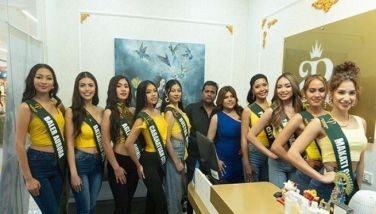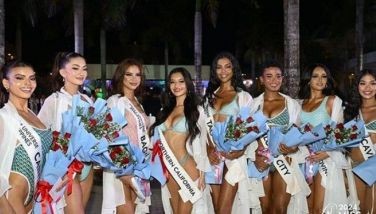Soap commercials through the years
May 25, 2002 | 12:00am
The other day, I wrote about how the burgers, pizzas and doughnuts of old were sold in the market even without the benefit of advertising. (This was before the arrival of McDonald’s, Shakey’s, Pizza Hut, Dunkin’ Donuts and Mister Donut).
However, there are consumer products that had always relied heavily on advertising because of fierce competition from rival brands. Some products, in fact, would buy into the whole hour of a radio or TV program and the show would end up carrying the name of the sponsor in the title. On radio, for instance, we had The Camay Theater, which – if radio-TV expert Edmund Sicam remembers correctly – was a soap opera. And then, of course, there was Caltex Star Caravan, one of the earliest programs on television, which offered different types of entertainment fare – from variety shows to plays by Fr. James Reuter.
There was also Reyna ng Vicks on radio and this was a contest among housewives with the weepiest of sob tales.
In the late ’50s, Nestor U. Torre also hosted at the age of 13 the local franchise (this was in Cagayan de Oro) of the Royal True-Orange Radio Schoolhouse, a quiz show conducted live at the town plaza.
In time, however, it became too expensive for just one product to sponsor one whole TV or radio program. Radio and TV shows therefore eventually allowed other sponsors to come into their programs in between commercial gaps. In fact, LG Digital Quiz and Globe’s TXTR 5 on Channel 7 today also entertain other sponsors – except those of rival products.
But whether these sponsors buy into the whole show or simply just put placements in particular program, the fact remains that some consumer products have always found it necessary to advertise on TV in order to make an impact on the market. Bath soaps are among these products. Below, let’s trace how bath soaps were sold through the years on television.
Lux, Camay, Lifebuoy, Safeguard and Palmolive were the leading bath soaps in the ’60s. In the beginning the local distributors of Lux aired here in Manila US-made TV commercial that featured foreign stars like Sandra Dee and Ursula Andress, for instance. Later, the local company also asked movie queens Susan Roces and Amalia Fuentes to endorse the beauty soap, which was then already starting to come out in different colors.
 Aside from its regular TV, radio and print commercials, Lux also conducted in the late ’60s a Lux Star of Stars search. This was actually a popularity contest open to all female movie stars of that era. The key to winning depended on the movie fans who had to send in as many empty boxes of Lux soap with the names of their favorite stars on it. The winner of this contest was Gloria Sevilla – with official Lux endorsers Susan Roces and Amalia Fuentes ending up only as her runners-up. Lux stopped the search after that and I think it was Liwayway Publishing House that continued the contest the following year. The winner was Anna Ledesma – with Susan Roces still a runner-up and Amalia Fuentes in Number 6.
Aside from its regular TV, radio and print commercials, Lux also conducted in the late ’60s a Lux Star of Stars search. This was actually a popularity contest open to all female movie stars of that era. The key to winning depended on the movie fans who had to send in as many empty boxes of Lux soap with the names of their favorite stars on it. The winner of this contest was Gloria Sevilla – with official Lux endorsers Susan Roces and Amalia Fuentes ending up only as her runners-up. Lux stopped the search after that and I think it was Liwayway Publishing House that continued the contest the following year. The winner was Anna Ledesma – with Susan Roces still a runner-up and Amalia Fuentes in Number 6.
Camay – in contrast – didn’t rely on established movie stars to endorse the product. But through the power of the TV medium, its models – known as Miss Camay or Camay Girl – eventually gained celebrity status right after the commercial is shown on television. Camay actually became the springboard to stardom of Maritess Revilla (who reigned longest as Miss Camay) and Toni Rose Gayda. Maritess later went on to do TV shows (as a semi-regular in Noontime Matinee and as the lead star of the sitcom Ay Mali and the variety show On With the Show) and nine movies with some of the local films’ top leading men Dolphy and Fernando Poe, Jr. (She’s now better known as the mother of Bianca Araneta.) And Toni? She’s still very much visible in the noontime program Eat Bulaga.
There were also Camay Girls who also sought bigger beauty titles after having been launched in the Camay commercials. Among them were Miss International Aurora Pijuan and Binibining Pilipinas-Universe Vida Doria.
The Camay Girls were really head-turners and all of them lived up to the product’s slogan: Ikaw ay mapapatingin... at muling mapapatingin.
Palmolive soap’s most popular endorser must have been Alice Dixson, whose Palmolive commercial ("I can feel it") first appeared in 1987. In the ’60s, however, Palmolive had a very memorable TV ad that ran on the air for a long time. Set at the old Manila International Airport (the one that burned down), it showed two ladies in their mid-20s bumping into each other at the moving escalator (one was going up, while the other one was going down). After they went separate ways, the lady going up the escalator said to her male companion, "Classmate ko siya sa high school 10 years ago." To this, the male companion retorted rather tactlessly, "Bakit mas mukhang bata siya sa iyo?" Too bad for her (so the commercial implied), she didn’t use Palmolive soap, while her high school classmate of 10 years ago did.
The Kaminomoto soap commercial was different from the TV ads of Lux, Camay and Palmolive because it was daring enough to have suggested sex in its television advertisement. (This was in the prudish 1960s). The commercial featured movie actress Vilma Valera taking a shower and the camera showed her – with each scene in close-up – soaping her naked back, arms and legs. A long shot (supposedly from outside a building) also showed in silhouette form Ms. Valera’s naked body framed by a window. The controversy generated by this commercial, unfortunately, didn’t translate into sales. Kaminomoto soap eventually disappeared from the supermarket shelves.
Wholesome as ever were the commercials of Safeguard, which was always marketed as a family soap. Even in the ’60s, the Safeguard ad always showed a family using the soap. The father soaped himself with it to prevent body odor, the young son washed his wound with it to fight infection, while the teenage daughter used it on her face as a beauty aid. Strangely enough, the mother never took a bath in any of the Safeguard commercials.
In the late ’60s, Safeguard recommended a beauty ritual in one of its ads, which showed a teenage girl leaving the soap lather on her face for one minute. It was supposed to make our face smoother, cleaner and pimple-free. Believe it or not, there were a lot of people who tried this beauty remedy. But whether or not they developed clear and smooth complexion – or ended up with dry skin (imagine leaving soap lather on your face that long) is not known.
A bath soap that shot up in sales even without the promise of beautiful skin or anything is Dial. Originally imported from US, Dial soap first catered only to the AB bracket. When it was eventually manufactured locally, the soap company courted the CD market by making Nora Aunor appear in its television commercial. And so, we saw Nora (at the peak of her superstardom) taking a shower (with Dial soap, of course), while singing, "Aren’t you glad you used Dial?"
This one commercial really turned things around. Thanks to the endorsement of Nora Aunor, the masa, which is a bigger market, also started buying Dial – to the chagrin and horror of people from the upper bracket, who were afraid that they and the plebeian class would end up smelling alike.
(To be concluded)
However, there are consumer products that had always relied heavily on advertising because of fierce competition from rival brands. Some products, in fact, would buy into the whole hour of a radio or TV program and the show would end up carrying the name of the sponsor in the title. On radio, for instance, we had The Camay Theater, which – if radio-TV expert Edmund Sicam remembers correctly – was a soap opera. And then, of course, there was Caltex Star Caravan, one of the earliest programs on television, which offered different types of entertainment fare – from variety shows to plays by Fr. James Reuter.
There was also Reyna ng Vicks on radio and this was a contest among housewives with the weepiest of sob tales.
In the late ’50s, Nestor U. Torre also hosted at the age of 13 the local franchise (this was in Cagayan de Oro) of the Royal True-Orange Radio Schoolhouse, a quiz show conducted live at the town plaza.
In time, however, it became too expensive for just one product to sponsor one whole TV or radio program. Radio and TV shows therefore eventually allowed other sponsors to come into their programs in between commercial gaps. In fact, LG Digital Quiz and Globe’s TXTR 5 on Channel 7 today also entertain other sponsors – except those of rival products.
But whether these sponsors buy into the whole show or simply just put placements in particular program, the fact remains that some consumer products have always found it necessary to advertise on TV in order to make an impact on the market. Bath soaps are among these products. Below, let’s trace how bath soaps were sold through the years on television.
Lux, Camay, Lifebuoy, Safeguard and Palmolive were the leading bath soaps in the ’60s. In the beginning the local distributors of Lux aired here in Manila US-made TV commercial that featured foreign stars like Sandra Dee and Ursula Andress, for instance. Later, the local company also asked movie queens Susan Roces and Amalia Fuentes to endorse the beauty soap, which was then already starting to come out in different colors.
 Aside from its regular TV, radio and print commercials, Lux also conducted in the late ’60s a Lux Star of Stars search. This was actually a popularity contest open to all female movie stars of that era. The key to winning depended on the movie fans who had to send in as many empty boxes of Lux soap with the names of their favorite stars on it. The winner of this contest was Gloria Sevilla – with official Lux endorsers Susan Roces and Amalia Fuentes ending up only as her runners-up. Lux stopped the search after that and I think it was Liwayway Publishing House that continued the contest the following year. The winner was Anna Ledesma – with Susan Roces still a runner-up and Amalia Fuentes in Number 6.
Aside from its regular TV, radio and print commercials, Lux also conducted in the late ’60s a Lux Star of Stars search. This was actually a popularity contest open to all female movie stars of that era. The key to winning depended on the movie fans who had to send in as many empty boxes of Lux soap with the names of their favorite stars on it. The winner of this contest was Gloria Sevilla – with official Lux endorsers Susan Roces and Amalia Fuentes ending up only as her runners-up. Lux stopped the search after that and I think it was Liwayway Publishing House that continued the contest the following year. The winner was Anna Ledesma – with Susan Roces still a runner-up and Amalia Fuentes in Number 6.
Camay – in contrast – didn’t rely on established movie stars to endorse the product. But through the power of the TV medium, its models – known as Miss Camay or Camay Girl – eventually gained celebrity status right after the commercial is shown on television. Camay actually became the springboard to stardom of Maritess Revilla (who reigned longest as Miss Camay) and Toni Rose Gayda. Maritess later went on to do TV shows (as a semi-regular in Noontime Matinee and as the lead star of the sitcom Ay Mali and the variety show On With the Show) and nine movies with some of the local films’ top leading men Dolphy and Fernando Poe, Jr. (She’s now better known as the mother of Bianca Araneta.) And Toni? She’s still very much visible in the noontime program Eat Bulaga.
There were also Camay Girls who also sought bigger beauty titles after having been launched in the Camay commercials. Among them were Miss International Aurora Pijuan and Binibining Pilipinas-Universe Vida Doria.
The Camay Girls were really head-turners and all of them lived up to the product’s slogan: Ikaw ay mapapatingin... at muling mapapatingin.
Palmolive soap’s most popular endorser must have been Alice Dixson, whose Palmolive commercial ("I can feel it") first appeared in 1987. In the ’60s, however, Palmolive had a very memorable TV ad that ran on the air for a long time. Set at the old Manila International Airport (the one that burned down), it showed two ladies in their mid-20s bumping into each other at the moving escalator (one was going up, while the other one was going down). After they went separate ways, the lady going up the escalator said to her male companion, "Classmate ko siya sa high school 10 years ago." To this, the male companion retorted rather tactlessly, "Bakit mas mukhang bata siya sa iyo?" Too bad for her (so the commercial implied), she didn’t use Palmolive soap, while her high school classmate of 10 years ago did.
The Kaminomoto soap commercial was different from the TV ads of Lux, Camay and Palmolive because it was daring enough to have suggested sex in its television advertisement. (This was in the prudish 1960s). The commercial featured movie actress Vilma Valera taking a shower and the camera showed her – with each scene in close-up – soaping her naked back, arms and legs. A long shot (supposedly from outside a building) also showed in silhouette form Ms. Valera’s naked body framed by a window. The controversy generated by this commercial, unfortunately, didn’t translate into sales. Kaminomoto soap eventually disappeared from the supermarket shelves.
Wholesome as ever were the commercials of Safeguard, which was always marketed as a family soap. Even in the ’60s, the Safeguard ad always showed a family using the soap. The father soaped himself with it to prevent body odor, the young son washed his wound with it to fight infection, while the teenage daughter used it on her face as a beauty aid. Strangely enough, the mother never took a bath in any of the Safeguard commercials.
In the late ’60s, Safeguard recommended a beauty ritual in one of its ads, which showed a teenage girl leaving the soap lather on her face for one minute. It was supposed to make our face smoother, cleaner and pimple-free. Believe it or not, there were a lot of people who tried this beauty remedy. But whether or not they developed clear and smooth complexion – or ended up with dry skin (imagine leaving soap lather on your face that long) is not known.
A bath soap that shot up in sales even without the promise of beautiful skin or anything is Dial. Originally imported from US, Dial soap first catered only to the AB bracket. When it was eventually manufactured locally, the soap company courted the CD market by making Nora Aunor appear in its television commercial. And so, we saw Nora (at the peak of her superstardom) taking a shower (with Dial soap, of course), while singing, "Aren’t you glad you used Dial?"
This one commercial really turned things around. Thanks to the endorsement of Nora Aunor, the masa, which is a bigger market, also started buying Dial – to the chagrin and horror of people from the upper bracket, who were afraid that they and the plebeian class would end up smelling alike.
(To be concluded)
BrandSpace Articles
<
>
- Latest
- Trending
Trending
Latest
Trending
Latest
Recommended



























 Exclusive
Exclusive




